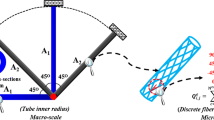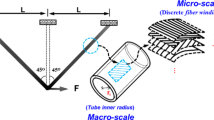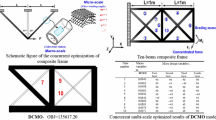Abstract
The paper proposes an efficient methodology for concurrent reliability-based multi-scale design optimization (RBMDO) of composite frames to minimize structural cost subjecting to compliance constraint. Two types of variables are systematically considered in RBMDO, which are deterministic design variables of the frame components, the discrete fiber winding angles at the two geometrical scales, and random parameters of material properties and loading conditions in both magnitude and direction. To overcome the difficulty of highly nonlinear compliance constraint when using fiber winding angles as design variables and improve efficiency and accuracy of RBMDO of composite frames, the improved single loop and single vector (SLSV) approach based on modified chaos control (MCC) scheme, which is abbreviated hereafter as SLSV-MCC, is proposed, and sensitivities at the current design point are utilized to further increase accuracy of the proposed SLSV-MCC. Six types of specific manufacturing constraints are explicitly considered in the proposed RBMDO to reduce the risk of local failure in the laminated composite. The deterministic multi-scale design optimization (DMDO) model is also presented and utilized for comparison to distinguish differences between deterministic and reliability-based optimization results. Efficiency and accuracy of the proposed SLSV-MCC are compared with the first-order reliability method (FORM) and conventional SLSV approach. Meanwhile, the Monte Carlo simulation (MCS) method is further utilized to validate the accuracy of the proposed RBMDO. The discrete material optimization (DMO) approach is utilized to couple two geometrical scales: macroscopic topology and microscopic material selection. Capabilities of the proposed RBMDO are demonstrated by optimization of 2D and 3D composite frames. Numerical study reveals that the uncertainties in material properties and loading conditions will lead to different macroscopic sizing and topology configurations for deterministic and reliability-based solutions.

















Similar content being viewed by others
References
Andreasen CS, Sigmund O (2012) Multiscale modeling and topology optimization of poroelastic actuators. Smart Mater Struct 21(6):065–005
António CC, Hoffbauer LN (2009) An approach for reliability-based robust design optimisation of angle-ply composites. Compos Struct 90(1):53–59
Bailie JA, Ley RP, Pasricha A (1997) A summary and review of composite laminate design guidelines, technical report NASA, NAS1–19347, Northrop Grumman-military aircraft systems division, Final 22
Bendsøe MP, Sigmund O (2013) Topology optimization: theory, methods, and applications. Springer Science & Business Media
Blasques JP, Lazarov B (2012) User's Manual for BECAS: A cross section analysis tool for anisotropic and inhomogeneous beam sections of arbitrary geometry. Risø DTU–National Laboratory for Sustainable Energy
Chen X, Hasselman T, Neill D (1997) Reliability based structural design optimization for practical applications, 38th Structures, structural dynamics, and materials conference., 1403
Chiralaksanakul A, Mahadevan S (2005) First-order approximation methods in reliability-based design optimization. J Mech Des 127(5):851–857
Coelho PG, Fernandes PR, Guedes JM, Rodrigues HC (2008) A hierarchical model for concurrent material and topology optimisation of three-dimensional structures. Struct Multidiscip Optim 35(2):107–115
Cheng GD, Olhoff N (1993) Rigid body motion test against error in semianalytical sensitivity analysis. Comput Struct 46(3):515–527
Cho HY, Choi KK, Gaul NJ, Lee IJ, Lamb D, Gorsich D (2016) Conservative reliability-based design optimization method with insufficient input data. Struct Multidiscip Optim 54(6):1609–1630
Deng JD, Chen W (2017) Concurrent topology optimization of multiscale structures with multiple porous materials under random field loading uncertainty. Struct Multidiscip Optim 56(1):1–19
Deng JD, Yan J, Cheng GD (2013) Multi-objective concurrent topology optimization of thermoelastic structures composed of homogeneous porous material. Struct Multidiscip Optim 47(4):583–597
Denny M (2001) Introduction to importance sampling in rare-event simulations. Eur J Phys 22(4):403
Kiureghian AD, Lin HZ, Hwang SJ (1987) Second-order reliability approximations. J Eng Mech 113(8):1208–1225
Keshtegar B, Hao P, Meng Z (2017) A self-adaptive modified chaos control method for reliability-based design optimization. Struct Multidiscip Optim 55(1):63–75
Duan ZY, Yan J, Zhao GZ (2015) Integrated optimization of the material and structure of composites based on the Heaviside penalization of discrete material model. Struct Multidiscip Optim 51(3):721–732
Duan ZY, Yan J, Lee IJ, Wang JY, Yu T (2018) Integrated design optimization of composite frames and materials for maximum fundamental frequency with continuous fiber winding angles. Acta Mech Sinica 34(6):1084–1094
Duan ZY, Yan J, Lee IJ, Lund E, Wang JY (2019a) A two-step optimization scheme based on equivalent stiffness parameters for forcing convexity of Fiber winding angle in composite frames. Struct Multidiscip Optim 59(6):2111–2129
Ferreira RTL, Rodrigues HC, Guedes JM, Hernandes JA (2013) Hierarchical optimization of laminated fiber reinforced composites. Compos Struct 107:246–259
Foldager J, Hansen JS, Olhoff N (1998) A general approach forcing convexity of ply angle optimization in composite laminates. Struct Optim 16(2–3):201–211
Gao T, Zhang WH, Duysinx P (2013) Simultaneous design of structural layout and discrete fiber orientation using bi-value coding parameterization and volume constraint. Struct Multidiscip Optim 48(6):1075–1088
Guo X, Bai W, Zhang W, Gao X (2009) Confidence structural robust design and optimization under stiffness and load uncertainties. Comput Methods Appl Mech Eng 198(41–44):3378–3399
Guo X, Zhao X, Zhang W, Yan J, Sun G (2015) Multi-scale robust design and optimization considering load uncertainties. Comput Methods Appl Mech Eng 283:994–1009
Helton JC, Davis FJ (2003) Latin hypercube sampling and the propagation of uncertainty in analyses of complex systems. Reliab Eng Syst Saf 81(1):23–69
Huu VH, Duong-Gia D, Vo-Duy T, Le-Duc T (2018) Nguyen-Thoi, an efficient combination of multi-objective evolutionary optimization and reliability analysis for reliability-based design optimization of truss structures. Expert Syst Appl 102:262–272
Hvejsel CF, Lund E (2011) Material interpolation schemes for unified topology and multi-material optimization. Struct Multidiscip Optim 43(6):811–825
Imani M, Ghoreishi SF, Braga-Neto UM (2018) Bayesian control of large MDPs with unknown dynamics in data-poor environments. Adv Neural Inf Proces Syst:8146–8156
Imani M, Ghoreishi SF, Allaire D, Braga-Neto UM (2019) MFBO-SSM: multi-fidelity Bayesian optimization for fast inference in state-space models. Proc AAAI Conf Artif Intell 33:7858–7865
Jeong SB, Park GJ (2017) Single loop single vector approach using the conjugate gradient in reliability based design optimization. Struct Multidiscip Optim 55(4):1329–1344
Jung Y, Cho H, Lee IJ (2019) MPP-based approximated DRM (ADRM) using simplified bivariate approximation with linear regression. Struct Multidiscip Optim 59(5):1761–1773
Kang SB, Park JW, Lee IJ (2017) Accuracy improvement of the most probable point-based dimension reduction method using the hessian matrix. Int J Numer Methods Eng 111(3):203–217
Lee IJ, Choi KK, Du L, Gorsich D (2008) Inverse analysis method using MPP-based dimension reduction for reliability-based design optimization of nonlinear and multi-dimensional systems. Comput Methods Appl Mech Eng 198(1):14–27
Lee IJ, Choi KK, Gorsich D (2010) Sensitivity analyses of FORM-based and DRM-based performance measure approach (PMA) for reliability-based design optimization (RBDO). Int J Numer Methods Eng 82(1):26–46
Lee IJ, Noh Y, Yoo D (2012) A novel second-order reliability method (SORM) using noncentral or generalized chi-squared distributions. J Mech Des 134(10):100912
Liu L, Yan J, Cheng GD (2008) Optimum structure with homogeneous optimum truss-like material. Comput Struct 86(13):1417–1425
Ma XT, Tian K, Li HQ, Zhou Y, Hao P, Wang B (2020) Concurrent multi-scale optimization of hybrid composite plates and shells for vibration. Compos Struct 233:111635
Mallick PK (2007) Fiber-reinforced composites: materials, manufacturing, and design. CRC press
Lund E (1994) Finite element based design sensitivity analysis and optimization. Institute of Mechanical Engineering, Aalborg University, Denmark
Martins LAL, Bastian FL, T.A. (2014) Netto, reviewing some design issues for filament wound composite tubes. Mater Des 55:242–249
Niu B, Yan J, Cheng GD (2009) Optimum structure with homogeneous optimum cellular material for maximum fundamental frequency. Struct Multidiscip Optim 39(2):115–132
Papadrakakis M, Lagaros ND (2002) Reliability-based structural optimization using neural networks and Monte Carlo simulation. Comput Methods Appl Mech Eng 191(32):3491–3507
Rodrigues H, Guedes JM, Bendsøe M (2002) Hierarchical optimization of material and structure. Struct Multidiscip Optim 24(1):1–10
Rosenblatt M (1952) Remarks on a multivariate transformation. Ann Math Stat 23:470–472
Shin JW, Lee IJ (2014) Reliability-based vehicle safety assessment and design optimization of roadway radius and speed limit in windy environments. J Mech Des 136.8
Sohouli A, Yildiz M, Suleman A (2018) Efficient strategies for reliability-based design optimization of variable stiffness composite structures. Struct Multidiscip Optim 57(2):689–704
Sørensen SN, Sørensen R, Lund E (2014) DMTO–a method for discrete material and thickness optimization of laminated composite structures. Struct Multidiscip Optim 50(1):25–47
Stegmann J, Lund E (2005) Discrete material optimization of general composite shell structures. Int J Numer Methods Eng 62(14):2009–2027
Shimoda M, Nagano T, Shi JX (2019) Non-parametric shape optimization method for robust design of solid, shell, and frame structures considering loading uncertainty. Struct Multidiscip Optim 59(5):1543–1565
Wu C, Gao YK, Fang JG, Lund E, Li Q (2019) Simultaneous discrete topology optimization of ply orientation and thickness for carbon Fiber reinforced plastic-laminated structures. J Mech Des 141(4):044–501
Xu YN, Gao YK, Wu C, Fang JG, Li Q (2019) Robust topology optimization for multiple fiber-reinforced plastic (FRP) composites under loading uncertainties. Struct Multidiscip Optim 59(3):695–711
Xie SL, Imani M, Dougherty ER, Braga-Neto UM (2017) Nonstationary linear discriminant analysis. 51st Asilomar Conference on Signals, Systems, and Computers, Pacific Grove, CA, pp 161–165
Yan J, Duan ZY, Lund E, Wang JY (2017) Concurrent multi-scale design optimization of composite frames with manufacturing constraints. Struct Multidiscip Optim 56(3):519–533
Yan J, Cheng GD, Liu L (2008) A uniform optimum material based model for concurrent optimization of thermoelastic structures and materials. Int J Simul Multidiscip Des Optim 2(4):259–266
Yang DX, Yi P (2009) Chaos control of performance measure approach for evaluation of probabilistic constraints. Struct Multidiscip Optim 38:83–92
Yang DX, Li XL, Chen GH (2018) Accelerated stability transformation method for chaos control of discrete dynamical systems. Nonlinear Dyn 94(2):1195–1213
Youn BD, Choi KK, Park YH (2003) Hybrid analysis method for reliability-based design optimization. J Mech Des 125(2):221–232
Meng Z, Gang L, Wang BP, Hao P (2015) A hybrid chaos control approach of the performance measure functions for reliability-based design optimization. Comput Struct 146:32–43
Duan ZY, Yan J, Lee IJ, Lund E, Wang JY (2019b) Discrete material selection and structural topology optimization of composite frames for maximum fundamental frequency with manufacturing constraints. Struct Multidiscip Optim 60(5):1741–1758
Zuo ZH, Huang XD, Rong JH, Xie YM (2013) Multi-scale design of composite materials and structures for maximum natural frequencies. Mater Des 51:1023–1034
Funding
Financial supports for this research were provided by the National Natural Science Foundation of China (No. 11672057, U1906233 and 11732004), the National Key R&D Program of China (2017YFC0307203), the 111 project (B14013), the Fundamental Research Funds for the Central Universities (DUT19ZD204), the Korea Institute of Energy Technology Evaluation and Planning, and the Ministry of Trade Industry & Energy of the Republic of Korea (No. 20172010000830).
Author information
Authors and Affiliations
Corresponding authors
Ethics declarations
Conflict of interest
The authors declare that they have no conflict of interest.
Replication of results
The raw/processed data required to reproduce these findings will be made available upon request by contact with the corresponding authors.
Additional information
Responsible Editor: Jianbin Du
Publisher’s note
Springer Nature remains neutral with regard to jurisdictional claims in published maps and institutional affiliations.
Appendix A: Evaluation of convergence
Appendix A: Evaluation of convergence
The convergence measure given in Stegmann and Lund (2005) is adopted to describe whether the optimization has converged to a satisfactory result, i.e., a single candidate material has been chosen in a specified element and all other materials have been discarded. For each layer, the following inequality is evaluated as
where ε is the tolerance, typically, ε ∈ [0.95~0.99]. If the inequality in (A-1) is satisfied for any ωi, j, c in the j-th layer, then the layer is flagged as converged. The convergence assessment criterion Hε is defined as the ratio between the number of converged layers \( {N}_c^{l, tot} \) and the total number of layers Nl, tot. Nlay is the number of layers in each tube, and it is assumed that each tube has the same number of layers in the paper. Ntub is the number of tubes in the frame structure. Thus, Nl, tot can be expressed as the number of tubes multiplied by the number of layers in a tube, that is, Nl, tot = Ntub ∙ Nlay. Then, the convergence assessment Hε can be expressed as
If the tolerance is 0.95 and the optimization is fully converged, i.e., Hε = 0.95 = 1, all layers have a single weight factor that contributes more than 95% to the Euclidian norm of the weight factors. More discussion about convergence criteria can be found in the references (Xu et al. 2019; Duan et al. 2015).
Rights and permissions
About this article
Cite this article
Duan, Z., Jung, Y., Yan, J. et al. Reliability-based multi-scale design optimization of composite frames considering structural compliance and manufacturing constraints. Struct Multidisc Optim 61, 2401–2421 (2020). https://doi.org/10.1007/s00158-020-02517-3
Received:
Revised:
Accepted:
Published:
Issue Date:
DOI: https://doi.org/10.1007/s00158-020-02517-3




